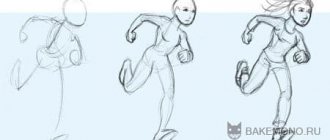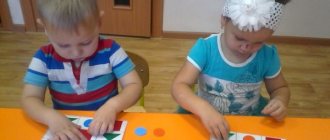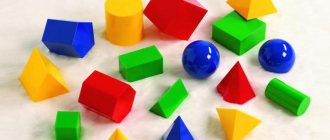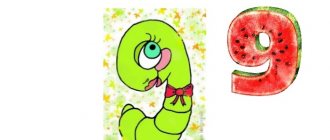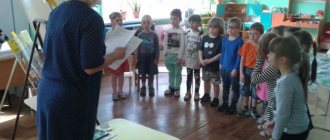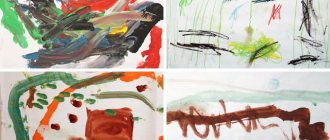The purpose of the didactic game “Figures”
The card index lists games with many didactic functions that ensure the comprehensive development of the child. But their common goal is to form an idea of geometric shapes.
General tasks:
- memorization and comprehension of geometric figures;
- consolidation of ideas about colors and outlines of surrounding objects;
- development of visual, including color, spatial and planar perception;
- improving the skills of comparative analysis, classification, generalization;
- memory training, concentration, intelligence, and the ability to think logically;
- formation of the skill of ordinal counting, primary mathematical knowledge;
- improvement of finger motor skills, general physical development;
- expansion of individual vocabulary, development of the skill of detailed answers to questions;
- nurturing perseverance, determination, independence, observation, the ability to act according to rules and instructions, and work productively in a team.
Senior group
We recommend these games on geometry for preschoolers in the older age group, that is, 5-6 years old.
Mosaic
For the game, prepare cards depicting objects made of geometric shapes. Invite the student to look carefully at the image, say what shapes he sees, whether they are large, whether there are many of them. Next, lay out the corresponding figures in front of the child and ask them to make an image similar to the one on the card.
When the preschooler begins to deftly complete the task, you can offer a complication: let him make an image without looking at the card. You can also invite the student to dream up: make another image from the same figures.
Pizza
To play, make a large circle - this will be the base of the pizza. Divide it into parts according to the number of children participating. Also cut out a lot of small shapes - this will be the filling for the pizza.
One child creates a geometric pattern on one of the pizza slices. The rest of the players must make the same pattern on their pieces. When the children have completed it, ask them what kind of figures they used and in what quantity.
If one child is playing, then name him the geometric objects that he should lay out as “filling”.
Fashionable glasses
For the game, prepare images of glasses with lenses of different geometric shapes. There should be holes instead of glass. Separately, cut out geometric shapes corresponding to the holes. The child’s task is to find suitable glasses for each glasses.
When the first task is completed, ask the student to find objects in the room and outside the window that are as close in shape as possible to the lenses of the glasses.
If two children are playing, encourage them to choose glasses with different lenses. Each player tries to find an object around that consists of two geometric shapes at once: like his own glasses and his friend’s glasses.
Ladybug wings
For the game, make images of ladybugs. They should have one wing, cut the second one separately. On the wings of insects, instead of black dots, different geometric shapes should be depicted; each ladybug has its own.
Lay out the blanks in front of the players, tell them that the bugs are playing too much and have lost their beautiful wings. We need to help them find them. Children find a suitable wing for each insect. Next, they count how many figured dots the bugs have on each wing and on both.
Find the extra figure
For the game, prepare cards, each of which depicts 4 geometric shapes. The game task is to find an object that does not correspond to the other three in most respects, and comment on the choice. For example, there is a small red circle, a large red circle, a small green circle, and a large yellow square. It is clear that the extra one is the last figure, since it does not correspond to the others in two of the three characteristics: shape and color.
Geometric competition
Make a playing field out of whatman paper: draw different figures on it. Two children are playing: they take turns throwing a die. For hitting a triangle, 1 point is given, for a square - 2 points, for a circle - 3 points, for a rectangle - 4 points. Before the game, you should agree on how many moves there will be. The player with the most points wins.
Collect the figures
For a board game, prepare images of figures lined up in a row. Moreover, objects should not be located chaotically, but in a certain order according to the principle of alternation. The task of the player who received the image is to continue the row and correctly select the next pieces in order. After completing the task, the player names the geometric objects that he used.
The game can be organized as a competitive one. Children play in pairs, the winner is the one who completes their row first. Further, it is possible to complicate the task: remove 2-3 objects from the row laid out by one player, and the second student must insert the correct figures into the empty areas.
Choose your figure
Prepare for the game large and small images of daisies with geometric shapes in the center. Place large flowers on the table. Let the children list the shapes they see. Ask the students to match each large daisy with a small one with a similar core.
Figured domino
For the game, make 28 pictures. Half of each of them should depict a certain geometric figure. Duplicate cards must have identical objects drawn on them. And the seventh duplicated picture must have both empty halves.
Place the cards on the table with the backs facing up. The game rules correspond to regular dominoes; the game starts with an empty duplicate card. The move is to lay out the card to the edge of the chain so that the same images are joined. If the player does not have a corresponding picture, then he takes the one he needs from the general pile. The first player to get rid of his cards wins.
Matryoshka dolls
For the game, prepare images of nesting dolls with geometric contours that form a pattern on the sundress. Separately cut out the shapes corresponding to the elements of the pattern.
Look at each geometric object with your children, let the children trace it with their finger and say what it is called. Next, invite the students to return the elegant look to the nesting doll sundresses. Children select shapes from a pile and place them on the contours of the sundress patterns.
